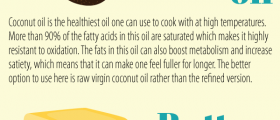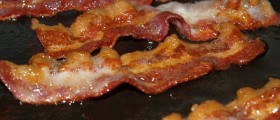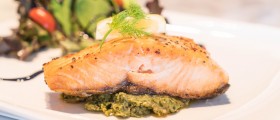Having belly fat is a problem that affects millions of people of all ages. Belly fat is extremely common and it is not unlikely to see that even slender people have a belly that they would be happy to get rid of. Excessive body fat commonly starts around the belly area and these reserves on the stomach are the hardest to lose even when losing in other areas.
However, belly fat is not just an aesthetic problem, it is a severe health concern, particularly dangerous when compared with other locations in one’s body. Excess belly fat increases one's risk of cardiovascular disease, diabetes, and certain types of cancers. However, a small number of lifestyle changes and a carefully planned diet may help to get rid of the belly fat.

Monounsaturated Fats and Belly Fat
Diet rich in monounsaturated fats is probably the best way to lose belly fat. The benefits of such an approach to losing weight are that there is no exercise required, targeted weight loss is achieved quickly, one will never feel hungry, the diet is pretty much easy to follow, it provides guaranteed results, and requires no deprivation.
A specially designed diet, based on monounsaturated fats, can flatten one’s belly with no exercise required. Normally diet lasts for one month but the real results are achieved once when people develop healthy eating habits.
Diet based on monounsaturated fats targets both the subcutaneous and visceral fat which is the inner fat, which surrounds the organs.
Monounsaturated Fats
Monounsaturated fats are also known as “good fats”. These are able to lower the bad cholesterol (LDL) and raise the levels of good cholesterol (HDL). However, their true ability to raise HDL is still in debate. Diet rich in fats has a strong impact on consumers' satiety. It will induce the feeling of fullness and prevent frequent food cravings.
Monounsaturated fats have many of the same heart-protective features as polyunsaturated fats, but, in addition, they have the ability to improve control of blood sugar in persons with non-insulin dependent diabetes.
- When examined as a ratio of upper-to-lower body fat mass, the high-carbohydrate diet induced a significantly higher ratio than the high-MUFA diet (P
- A more recent crossover study that fed 11 insulin-resistant adults high-SFA, high-MUFA, and high-carbohydrate diets in a random order for 28 days each also failed to document additional effects of increased MUFA intake on body weight and fat mass loss. However, the MUFA-rich diet did prevent upper body fat accumulation that was induced by the high-carbohydrate diet. Consequently, the upper-to-lower body fat ratio was significantly higher in that diet group.
- Similar to the aforementioned studies, one study documented greater upper body fat loss after following a high-MUFA diet (vs. a high-SFA diet) for 4 weeks. This study also recorded significant losses in body weight and total body fat mass, which was not found in the other two studies. Differences in the study populations may explain the contradictory observations regarding total body fat mass loss: studies that included adults with T2DM or insulin resistance reported no additional benefits of MUFA on body weight and fat mass, while studies that recruited healthy male adults did. Impaired fatty acid oxidation has been previously reported in adults with T2DM.
- The randomized controlled, parallel-arm studies that tested the effects of MUFA on body weight and body composition are limited, and were conducted using a weight loss paradigm. In one study, 57 overweight and obese adults were randomly assigned to follow a low-fat, high-protein (30% fat, 35% protein) or a high-fat, standard-protein (45% fat high in MUFA from mixed nuts and canola oil and 18% protein) diet. During the first 12 weeks of this trial, energy restriction was prescribed to promote weight loss; this was followed by an energy balance period of 4 weeks. This study did not find significant differences in body weight and fat mass loss between the two diets. The lack of effects of MUFA in this trial may be due to (1) the simultaneous manipulation of two dietary components (e.g. protein and fat); (2) the absence of a proper control group; (3) subtle acute physiological effects of MUFA that failed to translate into clinical observations; or (4) adaptation of the body to increased dietary MUFA during the study period.
- Another randomized controlled trial compared the weight- and fat-mass-reducing effects of a high-MUFA (from almonds) vs. a high-carbohydrate energy-restricted diet for 24 weeks. Like the previous study, the two intervention diets differed in more than one aspect: the MUFA diet contained higher total fat and lower carbohydrate (39% fat, 32% carbohydrate) than the high-carbohydrate diet (19% fat, 53% carbohydrate). In this study, greater reductions in weight (?18% vs. ?11%), fat mass (?30% vs. 20%), and waist circumference (an indicator of abdominal fat; ?14% vs. ?9%) were observed in the high-MUFA group, although it should be pointed out that these superior clinical outcomes may not be attributable to MUFA alone.
The Mediterranean diet, famous for its great health benefits, utilizes high levels of monounsaturated fats. Olive oil, a key component of the Mediterranean diet, contains approximately 75% monounsaturated fats.
Food Sources for Monounsaturated Fats
Good food sources for monounsaturated fats are pumpkins and sunflower seeds, almonds, avocados, black and green olives, dark chocolate, olive, walnut, sunflower, sesame, and peanut oils. Tea seed oil is commonly over 80% monounsaturated fat and Canola oil is about 58% monounsaturated fat.
Other sources include macadamia nut oil, grapeseed oil, groundnut oil (peanut oil), sesame oil, corn oil, popcorn, whole grain wheat, cereal, oatmeal, safflower oil, tea-oil Camellia, and avocado oil.

















Your thoughts on this
Loading...